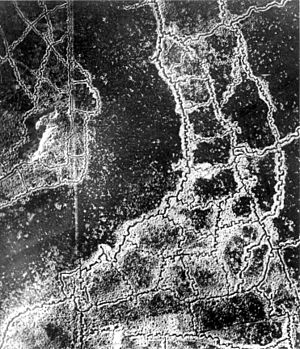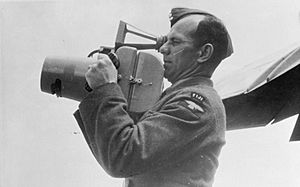Frederick Charles Victor Laws facts for kids
Quick facts for kids
Frederick Charles Victor Laws
|
|
|---|---|
| Nickname(s) | "Daddy" |
| Born | 29 November 1887 Thetford, Norfolk, England |
| Died | 27 October 1975 (aged 91) |
| Allegiance | United Kingdom |
| Service/ |
British Army Royal Air Force |
| Years of service | 1905–1923 1939–1946 |
| Rank | Group Captain |
| Unit | Coldstream Guards No. 1 Balloon Company No. 3 Squadron RFC Lincolnshire Regiment |
| Commands held | RAF School of Photography |
| Battles/wars | World War I World War II |
| Awards | Order of the Bath Order of the British Empire Legion of Merit (USA) |
Group Captain Frederick Charles Victor Laws (born November 29, 1887 – died October 27, 1975) was an important officer in the Royal Air Force. He was a pioneer in using airplanes to survey land and was a key founder of British aerial reconnaissance, which means gathering information by taking pictures from the sky.
Contents
Early Military Adventures
Frederick Laws joined the Coldstream Guards on February 22, 1905. He was sent to places like Egypt and Sudan until 1912. To earn extra money, he took photos with his simple Kodak Bullseye box camera and sold them to other soldiers. He later joined the communication team to get access to the unit's special room for developing photos. He even tried sending messages to airplanes using mirrors and sunlight, a method called heliograph.
Laws came back to England in 1912. In December, he took a skill test at the headquarters of the new Royal Flying Corps (RFC) in South Farnborough. He passed and was rated as a top-level air mechanic. Within a few months, Laws was promoted to sergeant and put in charge of his squadron's photography section.
Laws was first assigned to the No. 1 Balloon Company. He started taking aerial photos from the Army airship called Beta. Laws made an important discovery: if he took vertical photos with a 60% overlap, he could create a stereoscopic (3D) effect when looking at them through a special viewer. This 3D view helped a lot with map-making and getting important information from the air photos.
The next year, Laws took similar photos from kites and early airplanes like Bleriot and Farman types. He also experimented with cameras at another RFC site. Since airships were given to the Royal Navy, Laws was chosen to help create an aerial reconnaissance unit using regular airplanes. This unit, which included B.E.2 biplanes, later became No. 3 Squadron RFC, the first British unit to use heavier-than-air aircraft.
World War I Contributions

When Britain entered World War I in 1914, they weren't very good at using airplanes for reconnaissance. They didn't have enough good cameras or lenses. Laws and his team first created the A-camera, and later the L-camera (named after Laws). The L-camera became the main camera used by British planes, usually attached to the side of the plane, pointing down. With Lieutenant John Moore-Brabazon, another aviation pioneer, Laws also built the L/B camera for special jobs later in the war.
Laws went to France with No. 3 Squadron RFC and set up the air reconnaissance teams. In February 1915, he joined the Experimental Photo Team, 1st Wing. He also became skilled as an observer and pilot.
On November 7, 1915, Laws was made a second lieutenant in the Lincolnshire Regiment and sent to work with the Royal Flying Corps. He was appointed an Assistant Equipment Officer and posted to the RFC Photo School at Farnborough.
On June 1, 1916, he was made an Equipment Officer with the temporary rank of captain. On December 22, 1916, he was made a Park Commander with the temporary rank of major. He worked at the main office of the Royal Flying Corps on the Western Front until the war ended.
By the end of the war, Laws was known as the best expert in aerial photography in England, and maybe even the world. On January 1, 1919, he was given the Officer of the Order of the British Empire award for his important work during the war. Two weeks later, on January 15, he married Madeleine Grace Mathews Withers in London.
Between the Wars
On August 1, 1919, Laws was given a permanent job in the RAF as a major (squadron leader) and left the army. He worked in the Research Department at the Air Ministry from 1919 to 1923. There, he helped create the F8 and F24 cameras, which became the main cameras used by the RAF in the next war. He was then made the leader of the RAF Photo School at Farnborough. On January 1, 1927, he was promoted to wing commander. He was sad that aerial photography wasn't as important during peacetime, so he retired from the RAF on September 1, 1933.
In 1933–34, he led a team to map Western Australia from the air for the H. Hemmings company, using two DH.84 Dragon airplanes. He also worked for the Western Mining Corporation of Australia until 1936, doing aerial survey work. From 1937 to 1939, he was a director at Williamsons, a company that made cameras.
World War II Service
Laws rejoined the RAF as a wing commander when World War II began. He worked in the Photography Section at RAF Headquarters in France until February 1940. Then, he was made Deputy Director of the Photography Department in the Air Ministry. When his American counterpart, Colonel George Goddard, met Laws in London, Goddard described him as "short in stature, very proper in manner."
On January 1, 1944, Laws was promoted to group captain. On September 19, he was made a Commander of the Order of the British Empire for his help in planning the D-Day landings in Normandy. In October 1945, he received the Legion of Merit award from the United States of America. Laws retired again on May 12, 1946, keeping his rank of group captain.
After the Wars
After the wars, Laws became a leader in commercial air surveys. He worked as the managing director for Fairey Air Surveys and the Photo Finish Recording Company from 1947 to 1963.
Laws also wrote many articles and books about aerial photography, sharing his knowledge and experience.
Images for kids




